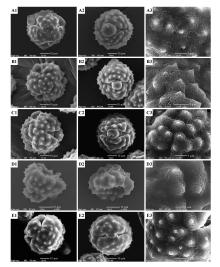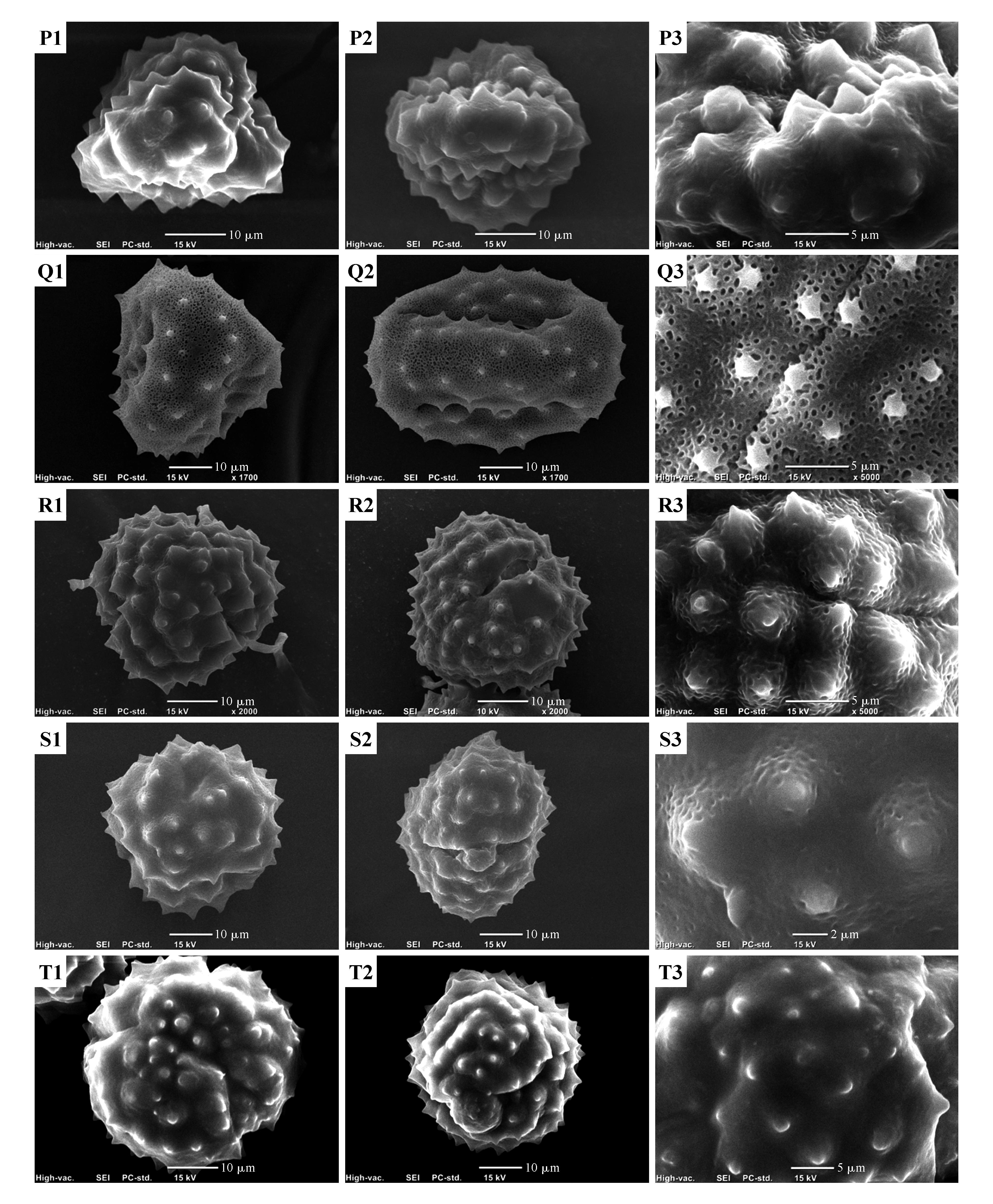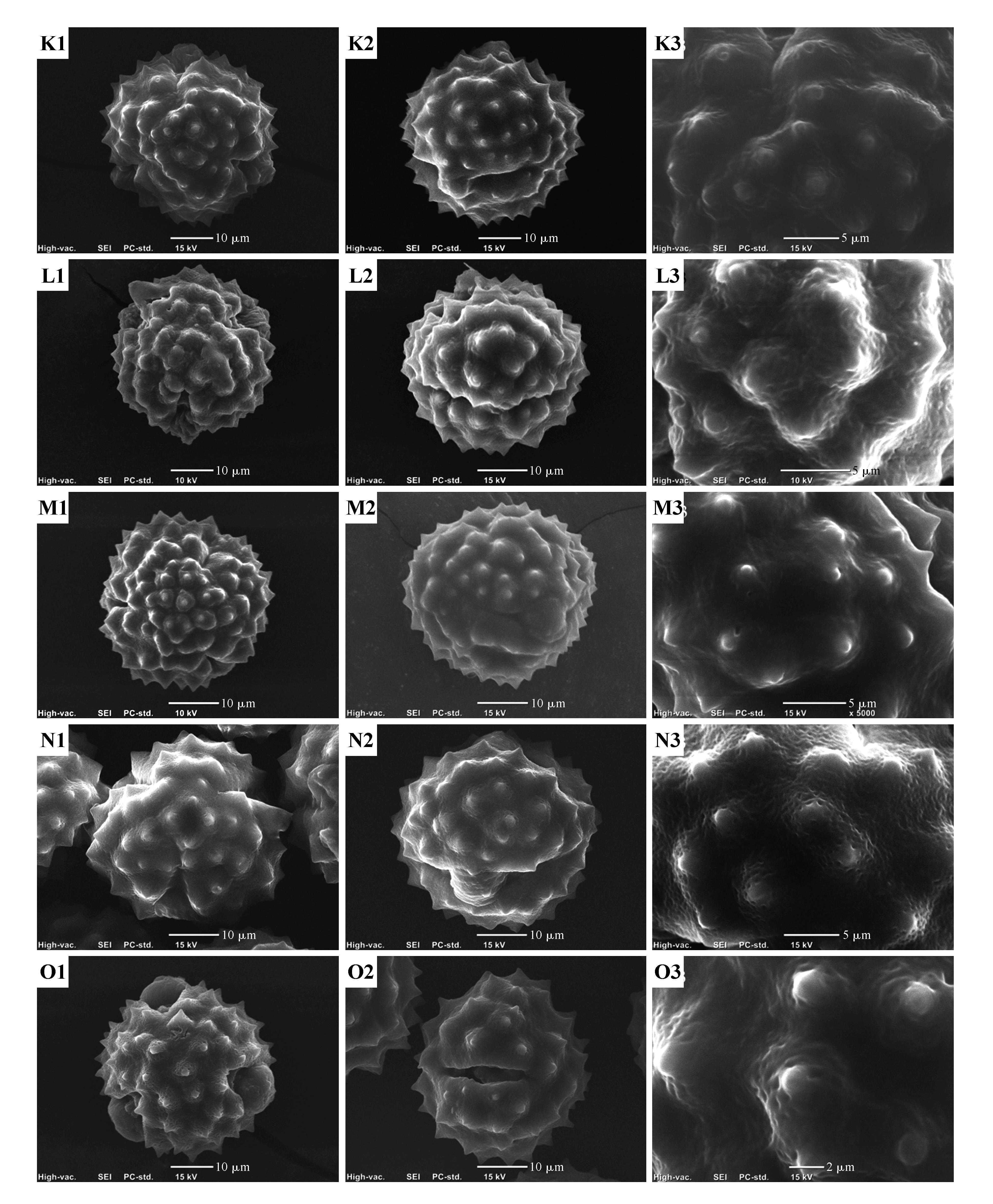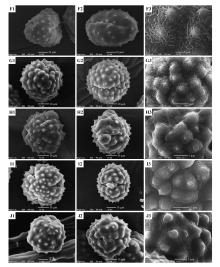植物研究 ›› 2023, Vol. 43 ›› Issue (5): 741-755.doi: 10.7525/j.issn.1673-5102.2023.05.011
张淑钧1,2,3,4, 杨欣欣1,2,3,4, 罗建1,2,3,4( )
)
收稿日期:2023-03-28
出版日期:2023-09-20
发布日期:2023-09-05
通讯作者:
罗建
E-mail:luojian@xza.edu.cn
作者简介:张淑钧(1999—),女,硕士研究生,主要从事植物分类和资源利用研究。
基金资助:
Shujun ZHNAG1,2,3,4, Xinxin YANG1,2,3,4, Jian LUO1,2,3,4( )
)
Received:2023-03-28
Online:2023-09-20
Published:2023-09-05
Contact:
Jian LUO
E-mail:luojian@xza.edu.cn
About author:ZHANG Shujun(1999—),female,postgraduate student,mainly engaged in plant taxonomy and resource utilization research.
Supported by:摘要:
采用扫描电镜对色季拉山区22种风毛菊属(Saussurea)植物花粉和1种须弥菊属(Himalaiella)植物花粉进行形态观察比较,了解花粉形态水平上的分化程度,同时进行聚类分析,以期为该属植物分类提供孢粉学依据,并进一步为该区风毛菊属植物的种质资源利用提供参考。结果表明:(1)23种植物花粉形状近球形有 20种,扁球形有3种;大部分花粉体积属于中型花粉,总体为较进化类型。(2)除薄苞风毛菊(S. leptolepis)为四孔沟花粉外,其余22种植物花粉具三孔沟。(3)23种植物花粉外壁纹饰具体可分为7种类型:网状最多为7种、网状—颗粒状6种、穴状6种,而光滑状、刺基穴状及刺间具皱波状、颗粒状和褶皱状各有1种。(4)基于23种植物花粉微形态的聚类分析,与植物分类系统表现出一定的一致性,甚至在部分亚属间也相对清晰。结果表明花粉微形态特征可以为该属物种鉴定提供依据。
中图分类号:
张淑钧, 杨欣欣, 罗建. 西藏色季拉山区风毛菊属植物花粉形态特征及其分类学意义[J]. 植物研究, 2023, 43(5): 741-755.
Shujun ZHNAG, Xinxin YANG, Jian LUO. Micromorphological Characteristics of Pollen and Its Taxonomic Significance of Saussurea in Sedgera Mountains of Tibet[J]. Bulletin of Botanical Research, 2023, 43(5): 741-755.
表1
实验材料基本信息
编号 No. | 种名 Species name | 分类[ Classification | 生境 Habitat | 海拔 Elevation/m | 凭证标本 Voucher specimen |
|---|---|---|---|---|---|
| 1 | 拉萨雪兔子 Saussurea kingii | 雪兔子亚属 Subgen. Eriocoryne | 河滩沙地、沙丘、山坡沙地 Beach sand,sand dunes, and hillside sand | 3 611.00 | 20141003315 |
| 2 | 绵头雪兔子 Saussurea laniceps | 雪兔子亚属 Subgen. Eriocoryne | 高山流石滩 Rugged rocks and pebbly shores | 4 800.00 | 627 |
| 3 | 鼠曲雪兔子 Saussurea gnaphalodes | 雪兔子亚属 Subgen. Eriocoryne | 山坡流石滩 Rocky slope and pebbly shore | 4 830.00 | LJ-006-028 |
| 4 | 硕首雪兔子 Saussurea grandiceps | 雪兔子亚属 Subgen. Eriocoryne | 高山流石滩 Pebble beach on a high mountain | 3 400.00 | 487 |
| 5 | 星状雪兔子 Saussurea stella | 雪兔子亚属 Subgen. Eriocoryne | 沼泽草地、河滩地 Marsh grassland,riverbank | 3 385.00 | SJ381 |
| 6 | 苞叶雪莲 Saussurea obvallata | 雪莲亚属 Subgen. Amphilaena | 山坡多石处 Rocky area on a hillside | 4 660.12 | QTP-LUO-1402 |
| 7 | 宝璐雪莲 Saussurea luae | 雪莲亚属 Subgen. Amphilaena | 山坡多石处 Rocky area on a hillside | 5 200.00 | QTP-LUO-2241 |
| 8 | 多鞘雪莲 Saussurea polycolea | 雪莲亚属 Subgen. Amphilaena | 山坡草地 Grassy slope | 4 600.00 | 520 |
| 9 | 毛背雪莲 Saussurea pubifolia | 雪莲亚属 Subgen. Amphilaena | 高山流石滩 Rocky shore on a high mountain | 5 200.00 | 2222 |
| 10 | 白背须弥菊 Himalaiella auriculata | 须弥菊属 Himalaiella | 河谷针阔混交林 Mixed coniferous and broad- leaved forest in a river valley | 2 100.00 | 980 |
| 11 | 尖叶风毛菊 Saussurea ciliaris | 风毛菊亚属裸托组 Subgen. Saussurea(Sect. Depressae) | 草坡、山地开阔处 Grassy slope,open area in the mountains | 4 629.48 | QTP-LUO-1382 |
| 12 | 黑苞风毛菊 Saussurea melanotricha | 风毛菊亚属无茎组 Subgen. Saussurea(Sect. Acaules) | 开阔石质山坡 Open rocky slope | 4 623.75 | QTP-LUO-1398 |
| 13 | 锥叶风毛菊 Saussurea wernerioides | 风毛菊亚属无茎组 Subgen. Saussurea(Sect. Acaules) | 山坡草地或砾石山坡 Grassy slope or rocky slope | 4 500.00 | QTP-2193 |
| 14 | 薄苞风毛菊 Saussurea leptolepis | 风毛菊亚属羽裂组 Subgen. Saussurea(Sect. Cyathidium) | 高山草甸 Alpine meadow | 4 830.00 | LJ-006-059 |
| 15 | 川滇风毛菊 Saussurea wardii | 风毛菊亚属羽裂组 Subgen. Saussurea(Sect. Cyathidium) | 山坡草地 Grassy slope | 4 180.00 | 13 |
| 16 | 倒披针叶风毛菊 Saussurea nimborum | 风毛菊亚属羽裂组 Subgen. Saussurea(Sect. Cyathidium) | 山坡草丛中、河滩草地 In a grassy slope,on a riverbank | 4 624.28 | QTP-LUO-1399 |
| 17 | 革苞风毛菊 Saussurea coriacea | 风毛菊亚属羽裂组 Subgen. Saussurea(Sect. Cyathidium) | 阶地 Terrace | 4 629.58 | QTP-LUO-1400 |
| 18 | 蒲公英风毛菊 Saussurea taraxacifolia | 风毛菊亚属羽裂组 Subgen. Saussurea(Sect. Cyathidium) | 山坡灌丛 Shrubbery on a hillside | 4 630.17 | QTP-LUO-1401 |
| 19 | 狮牙草状风毛菊 Saussurea leontodontoides | 风毛菊亚属羽裂组 Subgen. Saussurea(Sect. Cyathidium) | 山坡砾石地、草地 Rocky slope and grassy slope. | 4 000.00 | 587 |
| 20 | 松潘风毛菊 Saussurea sungpanensis | 风毛菊亚属羽裂组 Subgen. Saussurea(Sect. Cyathidium) | 山坡草地或砾石山坡 Grassy slope or rocky slope. | 4 500.00 | 512 |
| 21 | 弯齿风毛菊 Saussureaprzewalskii | 风毛菊亚属羽裂组 Subgen. Saussurea(Sect. Cyathidium) | 山坡灌丛草地、流石滩 Shrubbery and grassy slope, pebble beach. | 4 300.00 | 2235 |
| 22 | 紫苞风毛菊 Saussurea purpurascens | 风毛菊亚属羽裂组 Subgen. Saussurea(Sect. Cyathidium) | 山坡灌丛中 In shrubbery on a hillside. | 4 666.96 | QTP-LUO-652 |
| 23 | 粗裂风毛菊 Saussurea grosseserrata | 风毛菊亚属风毛菊组 Subgen. Saussurea(Sect. Saussurea) | 山坡草地或杜鹃灌丛中 Grassy slope or Rhododendron shrubbery on a hillside. | 4 665.19 | QTP-LUO-651 |
表2
23种植物花粉形态特征(1)
物种名称及编号 Species name and number | 极轴长P/μm | 赤道轴长E/μm | P/E | 萌发孔宽G/μm | 萌发沟长S/μm | 体积 V/μm3 | ||||
|---|---|---|---|---|---|---|---|---|---|---|
均值±标准误 Mean±SE | 偏差系数 Cv/% | 均值±标准误 Mean±SE | 偏差系数 Cv/% | 均值±标准误 Mean±SE | 偏差系数 Cv/% | 均值±标准误 Mean±SE | 偏差系数 Cv/% | |||
1.拉萨雪兔子 Saussurea kingii | 39.560±0.578i | 1.500 | 37.998±0.842i | 2.200 | 1.042 | 11.509±0.992b | 8.600 | 29.520±0.795f | 2.700 | 29 906.456 |
2.绵头雪兔子 Saussurea laniceps | 43.236±0.893e | 2.100 | 38.499±0.784i | 2.000 | 1.123 | 7.922±0.818i | 10.300 | 26.323±0.917j | 3.500 | 33 553.901 |
3.鼠曲雪兔子 Saussurea gnaphalodes | 43.291±0.949e | 2.200 | 41.867±0.827e | 2.000 | 1.034 | 12.588±0.880a | 7.000 | 27.580±0.695i | 2.500 | 39 731.423 |
4.硕首雪兔子 Saussurea grandiceps | 44.490±0.028c | 0.100 | 42.610±0.269e | 0.600 | 1.044 | 9.613±0.379c | 3.900 | 22.158±0.735l | 3.300 | 42 294.519 |
5.星状雪兔子 Saussurea stella | 42.602±0.774f | 1.800 | 41.415±0.916f | 2.200 | 1.029 | 10.081±0.893c | 8.900 | 28.044±0.677h | 2.400 | 40 547.279 |
6.苞叶雪莲 Saussurea obvallata | 41.223±0.662g | 1.600 | 41.843±0.232e | 0.600 | 0.985 | 7.479±0.853h | 11.400 | 30.124±0.508e | 1.700 | 37 789.243 |
7.宝璐雪莲 Saussurea luae | 11.927±0.810m | 6.800 | 10.970±0.303n | 2.800 | 1.075 | 2.709±0.268p | 9.900 | 7.680±0.548p | 7.100 | 751.503 |
8.多鞘雪莲 Saussurea polycolea | 40.495±0.007h | 0.100 | 40.075±0.035h | 0.100 | 1.010 | 6.883±0.817k | 11.900 | 24.853±0.868k | 3.500 | 34 052.349 |
9.毛背雪莲 Saussurea pubifolia | 47.233±1.322a | 2.800 | 45.307±1.66c | 3.700 | 1.044 | 11.331±0.750b | 6.600 | 30.407±0.900e | 3.000 | 50 765.823 |
10.白背须弥菊 Himalaiella auriculata | 41.682±0.663f | 1.600 | 40.452±0.911h | 2.300 | 1.031 | 9.950±0.962f | 9.700 | 27.550±0.912i | 3.300 | 35 713.068 |
11.尖叶风毛菊 Saussurea ciliaris | 28.903±0.894l | 3.100 | 34.397±0.885l | 2.600 | 0.840 | 2.603±0.059p | 2.300 | 13.305±0.436o | 3.300 | 17 905.204 |
12.黑苞风毛菊 Saussurea melanotricha | 46.581±0.882b | 1.900 | 43.239±0.800d | 1.900 | 1.078 | 8.344±0.769g | 9.200 | 31.825±0.373c | 1.200 | 45 599.356 |
13.锥叶风毛菊 Saussurea wernerioides | 42.020±0.990f | 2.400 | 40.523±0.826g | 2.000 | 1.037 | 9.102±0.867d | 9.500 | 18.510±0.991n | 5.400 | 36 129.158 |
14.薄苞风毛菊 Saussurea leptolepis | 45.123±0.614c | 1.400 | 43.207±0.618d | 1.400 | 1.044 | 9.628±0.674c | 7.000 | 30.947±0.590d | 1.900 | 44 106.370 |
15.川滇风毛菊 Saussurea wardii | 41.528±0.845f | 2.000 | 60.068±0.820b | 1.400 | 0.692 | 3.880±0.704o | 18.100 | 46.893±0.948a | 2.000 | 78 456.015 |
16.倒披针叶风毛菊 Saussurea nimborum | 41.270±0.354g | 0.900 | 41.655±0.035f | 0.100 | 0.991 | 8.479±0.932g | 11.000 | 25.540±0.389j | 1.500 | 37 494.482 |
17.革苞风毛菊 Saussurea coriacea | 41.687±0.909f | 2.200 | 40.163±0.977h | 2.400 | 1.038 | 6.177±0.297m | 4.800 | 32.695±0.120c | 0.400 | 35 209.129 |
18.蒲公英风毛菊 Saussurea taraxacifolia | 34.080±0.711k | 2.100 | 31.703±0.922m | 2.900 | 1.076 | 3.708±0.432o | 11.700 | 21.603±0.713m | 3.300 | 17 935.276 |
19.狮牙草状风毛菊 Saussurea leontodontoides | 43.793±0.654d | 1.500 | 43.623±0.304c | 0.700 | 1.004 | 8.800±0.706e | 8.000 | 28.854±0.907g | 3.100 | 43 635.938 |
20.松潘风毛菊 Saussurea sungpanensis | 36.987±0.542j | 1.500 | 38.397±0.316i | 0.800 | 0.963 | 8.310±0.610g | 7.300 | 28.528±0.800h | 2.800 | 28 551.627 |
21.弯齿风毛菊 Saussurea przewalskii | 37.200±0.752j | 2.000 | 36.017±0.929k | 2.600 | 1.033 | 6.575±0.411l | 6.200 | 22.033±0.960l | 4.400 | 25 266.704 |
22.紫苞风毛菊 Saussurea purpurascens | 43.200±0.658e | 1.500 | 62.303±0.644a | 1.000 | 0.693 | 5.487±0.842n | 15.300 | 38.035±0.967b | 2.500 | 87 802.105 |
23.粗裂风毛菊 Saussurea grosseserrata | 39.613±0.615i | 1.600 | 37.207±0.484j | 1.300 | 1.065 | 7.204±0.960j | 13.300 | 22.404±0.727l | 3.200 | 28 713.196 |
表3
23种植物花粉形态特征(2)
物种名称及编号 Species name and number | 网眼宽M/μm | 网脊宽W/μm | 刺宽WS/μm | 刺长LS/μm | 刺数 NS/400 μm2 | 纹饰 Ornamentation | ||||
|---|---|---|---|---|---|---|---|---|---|---|
均值±标准误 Mean±SE | 偏差系数 Cv(%) | 均值±标准误 Mean±SE | 偏差系数 Cv(%) | 均值±标准误 Mean±SE | 偏差系数 Cv(%) | 均值±标准误 Mean±SE | 偏差系数 Cv(%) | |||
1.拉萨雪兔子 Saussurea kingii | 0.443±0.070c | 15.800 | 0.347±0.051c | 14.800 | 4.211±0.991d | 23.500 | 3.759±0.673b | 17.900 | 17 | 网状-颗粒状 Reticular-granular |
2.绵头雪兔子 Saussurea laniceps | 0.540±0.078b | 14.400 | 0.278±0.048c | 17.100 | 4.597±0.839d | 18.200 | 3.742±0.853h | 22.800 | 21 | 网状-颗粒状 Reticulated-granular |
3.鼠曲雪兔子 Saussurea gnaphalodes | 0.486±0.074c | 15.200 | 0.381±0.092c | 24.000 | 4.008±0.723d | 18.100 | 2.748±0.499i | 16.100 | 17 | 网状 Reticulated |
4.硕首雪兔子 Saussurea grandiceps | 0.388±0.067c | 17.200 | 0.366±0.080c | 21.900 | 4.668±0.763e | 16.300 | 2.512±0.595j | 23.700 | 13 | 网状 Reticulated |
5.星状雪兔子 Saussurea stella | 一 | 一 | 一 | 一 | 2.129±0.384j | 18.100 | 1.871±0.416j | 22.300 | 20 | 粗糙具褶皱 Rough with folds |
6.苞叶雪莲 Saussurea obvallata | 0.365±0.038f | 10.400 | 0.266±0.051c | 19.100 | 5.154±0.763c | 14.800 | 3.656±0.543b | 14.800 | 9 | 穴状 Cavernous |
7.宝璐雪莲 Saussurea luae | 一 | 一 | 一 | 一 | 15.150±0.990a | 6.500 | 10.105±0.880a | 8.700 | 20 | 粗糙具颗粒 Coarsely granular with surface particles |
8.多鞘雪莲 Saussurea polycolea | 1.200±0.211a | 17.600 | 0.849±0.193b | 22.800 | 4.845±0.559c | 11.500 | 3.522±0.474d | 13.500 | 17 | 刺基穴状刺间具皱波状 Spiny basal apertures with wrinkled and undulating ridges between the spines |
9.毛背雪莲 Saussurea pubifolia | 0.364±0.037d | 10.300 | 0.294±0.042c | 14.400 | 4.992±0.627b | 12.600 | 3.573±0.679h | 19.000 | 11 | 网状 Reticulated |
10.白背须弥菊 Himalaiella auriculata | 0.297±0.044i | 15.000 | 0.202±0.020h | 9.800 | 5.846±0.837c | 14.300 | 3.707±0.562e | 15.200 | 10 | 穴状 Cavernous |
11.尖叶风毛菊 Saussurea ciliaris | 0.313±0.047h | 15.000 | 0.224±0.031g | 13.800 | 4.407±0.787g | 17.900 | 3.210±0.378f | 11.800 | 20 | 网状 Reticulated |
12.黑苞风毛菊 Saussurea melanotricha | 一 | 一 | 一 | 一 | 5.766±0.589b | 10.200 | 3.870±0.523b | 13.500 | 13 | 光滑状 Smooth in texture |
13.锥叶风毛菊 Saussurea wernerioides | 0.314±0.047g | 15.000 | 0.222±0.032f | 14.600 | 5.556±0.759b | 13.700 | 4.205±0.491b | 11.700 | 10 | 穴状 Cavernous |
14.薄苞风毛菊 Saussurea leptolepis | 0.401±0.054c | 13.600 | 0.321±0.051c | 16.000 | 4.819±0.681c | 14.100 | 3.525±0.246c | 7.000 | 19 | 网状 Reticulated |
15.川滇风毛菊 Saussurea wardii | 0.450±0.065c | 14.400 | 0.331±0.055c | 16.800 | 3.330±0.755i | 22.700 | 1.356±0.208k | 15.300 | 12 | 网状 Reticulated |
16.倒披针叶风毛菊 Saussurea nimborum | 0.358±0.034d | 9.600 | 0.317±0.082c | 25.700 | 4.979±0.699b | 14.000 | 3.443±0.357e | 10.400 | 16 | 网状-颗粒状 Reticulated-granular |
17.革苞风毛菊 Saussurea coriacea | 0.428±0.054c | 12.600 | 0.351±0.057c | 16.300 | 4.875±0.914b | 18.700 | 3.759±0.353c | 9.400 | 17 | 网状 Reticulated |
18.蒲公英风毛菊 Saussurea taraxacifolia | 0.312±0.027h | 8.800 | 0.257±0.028d | 11.000 | 4.253±0.535h | 12.600 | 3.178±0.286g | 9.000 | 20 | 穴状 Cavernous |
19.狮牙草状风毛菊 Saussurea leontodontoides | 0.341±0.050c | 14.600 | 0.268±0.034c | 12.700 | 5.293±0.850c | 16.100 | 3.667±0.334c | 9.100 | 18 | 网状-颗粒状 Reticulated-granular |
20.松潘风毛菊 Saussurea sungpanensis | 0.346±0.037e | 10.600 | 0.271±0.028d | 10.200 | 5.482±0.362b | 6.600 | 3.768±0.360c | 9.600 | 11 | 网状-颗粒状 Reticulated-granular |
21.弯齿风毛菊 Saussurea przewalskii | 0.378±0.073c | 19.300 | 1.104±0.139a | 12.600 | 4.320±0.729f | 16.900 | 3.298±0.389e | 11.800 | 25 | 网状-颗粒状 Reticulated-granular |
22.紫苞风毛菊 Saussurea purpurascens | 0.454±0.061c | 13.400 | 0.279±0.040d | 14.500 | 2.882±0.596j | 20.700 | 1.892±0.345j | 18.300 | 9 | 穴状 Cavernous |
23.粗裂风毛菊 Saussurea grosseserrata | 0.416±0.058c | 13.900 | 0.226±0.042e | 18.800 | 4.594±0.875c | 19.100 | 3.625±0.424e | 11.700 | 14 | 穴状 Cavernous |

图版Ⅰ
扫描电镜下的5种风毛菊属植物花粉微形态A.鼠曲雪兔子;B.硕首雪兔子;C.毛背雪莲;D.尖叶风毛菊;E.薄苞风毛菊;1~3分别为花粉粒极面观、赤道面观及花粉表面纹饰Plate Ⅰ Pollen micromorphology of five Saussurea species by scanning electron microscopeA.S. gnaphalodes;B.S. grandiceps;C.S. pubifolia;D.S. ciliaris;E.S. leptolepis;1-3 were polar view,equatorial view and ultrastructural view respectively


图版Ⅳ
扫描电镜下的5种风毛菊属植物花粉微形态P.蒲公英风毛菊;Q.紫苞风毛菊;R.粗裂风毛菊;S.白背须弥菊;T.黑苞风毛菊;示花粉粒的极面观(T1),赤道面观(T2)和花粉表面纹饰(T3)Plate Ⅳ Pollen micromorphology of 5 Saussurea species under SEMP.S. taraxacifolia;Q.S. purpurascens;R.S. grosseserrata;S.H. auriculata;T.S. melanotricha;T1-3 were polar view,equatorial view and ultrastructural view respectively


图版Ⅲ
扫描电镜下的5种风毛菊属植物花粉微形态K.狮牙草状风毛菊;L.松潘风毛菊;M.弯齿风毛菊;N.苞叶雪莲;O.锥叶风毛菊;示花粉粒的极面观(O1),赤道面观(O2)和花粉表面纹饰(O3)Plate Ⅲ The pollen micromorphology of 5 Saussurea species under SEMK.S. leontodontoides;L.S. sungpanensis;M.S. przewalskii;N.S. obvallata;O.S. wernerioides;O1-3 were polar view,equatorial view and ultrastructural view respectively


图版Ⅱ
扫描电镜下的5种风毛菊属植物花粉微形态F.川滇风毛菊;G.革苞风毛菊;H.拉萨雪兔子;I.绵头雪兔子;J.倒披针叶风毛菊;示花粉粒的极面观(J1),赤道面观(J2)和花粉表面纹饰(J3)Plate Ⅱ The pollen micromorphology of 5 Saussurea species by scanning electron microscopeF.S. wardii;G.S. coriacea;H.S. kingii;I.S. laniceps;J.S. nimborum;J1-3 were polar view,equatorial view and ultrastructural view respectively

| 1 | DE CANDOLLE A P.Saussurea DC.[M].Paris:Annales du Museum National d' Histoire Naturelle,1810:156,196,198. |
| 2 | HOOKER J D.Saussurea.The flora of British India:Vol.3[M].London:Reeve & Co.,Ltd.,NR.Ashford,Kent,England,1881:365-377. |
| 3 | BARANOV A, LIPSCHITZ S.Genus Saussurea DC.(Asteraceae)[M].London:Lenipopoli Science Press,1979. |
| 4 | WU Z Y, RAVEN P H, HONG D Y,et al.Flora of China Vol.20-21(Asteraceae)[M].Beijing:Science Press,2011. |
| 5 | 陈艺林,石铸.中国植物志:78卷:第2分册[M].北京:科学出版社,1999:1-56. |
| CHEN Y L, SHI Z.Flora of China:Vol.78:Div.2[M].Beijing:Science Press,1999:1-56. | |
| 6 | 中国科学院青藏高原综合科学考察队.西藏植物志:第4卷[M].北京:科学出版社,1985. |
| Integrated scientific expedition to the Qinghai-Tibet Plateau,Chinese Academy of Sciences.Flora of Tibet:Vol.Ⅳ[M].Beijing:Science Press,1985. | |
| 7 | 朱世新.河南风毛菊属植物的分类研究[D].郑州:河南农业大学,2001. |
| ZHU S X.A Taxonomic study on the genus Saussurea in Henan province[D].Zhengzhou:Henan Agricultural University,2001. | |
| 8 | 王一峰,王俊龙,吴依茜,等.甘肃风毛菊属植物区系地理研究及与邻近地区区系的关系[J].广西植物,2009,29(1):103-110. |
| WANG Y F, WANG J L, WU Y X,et al.Geographical study of the flora of Saussurea in Gansu and its relationship with the flora of neighboring areas[J].Guihaia,2009,29(1):103-110. | |
| 9 | 武素功,杨永平,费勇.青藏高原高寒地区种子植物区系的研究[J].云南植物研究,1995,17(3):233-250. |
| WU S G, YANG Y P, FEI Y.Study on the seed flora of the alpine region of Qinghai-Tibet Plateau[J].Acta Botanica Yunnanica,1995,17(3):233-250. | |
| 10 | HÄFFNER E.On the phylogeny of the subtribe Carduinae(tribe Cardueae,Compositae)[J].Botanischer Garten und Botanisches Museum,2000:3-208. |
| 11 | BREMER A, ANDERBERG A A, KARIS P O,et al.Asteraceae[J].Cladistics & ClassiFication,1994:135-137. |
| 12 | CHEN J, WANG Y J.New Saussurea(Asteraceae) species from Bogeda Mountain,eastern Tianshan,China,and inference of its evolutionary history and medical usage[J].PLoS One,2018,13(7):e0199416. |
| 13 | VON RAAB-STRAUBE E.Phylogenetic relationships in Saussurea(Compositae,Cardueae) sensu lato,inferred from morphological,ITS and trnL-trnF sequence Data,with a synopsis of Himalaiella gen.nov.,lipschitziella and frolovia[J].Botanischer Garten und Botanisches Museum,2003:379-402. |
| 14 | KITA Y, FUJIKAWA K, ITO M,et al.Molecular phylogenetic analyses and systematics of the genus Saussurea and related genera(Asteraceae,Cardueae)[J].International Association for Plant Taxonomy,2004,53(3):679-690. |
| 15 | 王剑虹.青藏高原东缘二十六种风毛菊属植物超微结构研究[D].兰州:西北师范大学,2008. |
| WANG J H.Ultrastructural study of twenty-six species of Saussurea on the eastern margin of the Tibetan Plateau[D].Lanzhou:Northwest Normal University,2008. | |
| 16 | 王伏雄,钱南芬,张玉龙,等.中国植物花粉形态[M].北京:科学出版社,1995:1-10,197-202. |
| WANG F X, QIAN N F, ZHANG Y L,et al.Pollen morphology of Chinese plants[M].Beijing:Science Press,1995:1-10,197-202. | |
| 17 | 王开发,王宪曾.孢粉学概论[M].北京:北京大学出版社,1983:23,32-34. |
| WANG K F, WANG X Z.Introduction to sporology[M].Beijing:Peking University Press,1983:23,32-34. | |
| 18 | 黄华,赖华清,蒋勇,等.箭叶淫羊藿与近缘种天平山淫羊藿花粉形态对比研究[J].广西植物,2020,40(9):1300-1314. |
| HUANG H, LAI H Q, JIANG Y,et al.Comparative study of pollen morphology of E.sagittatum and the closely related species E.myrianthum [J].Guihaia,2020,40(9):1300-1314. | |
| 19 | 李洪池,吴天彧,罗建.西藏色季拉山区龙胆科30种植物的花粉形态特征[J].园艺学报,2021,48(12):2427-2442. |
| LI H C, WU T Y, LUO J.Morphological characteristics of pollen from 30 species of plants of the Gentianaceae in the Sertisla Mountains,Tibet[J].Acta Horticulturae Sinica,2021,48(12):2427-2442. | |
| 20 | 曾心美,童芬,刘艳梅,等.丫蕊花属植物花粉和种子微形态特征比较及其分类学意义[J].西北植物学报,2017,37(4):695-704. |
| ZENG X M, TONG F, LIU Y M,et al.Comparison of micromorphological characters of pollen and seeds of Ypsilandra and their taxonomic significance[J].Acta Botanica Boreali-Occidentalia Sinica,2017,37(4):695-704. | |
| 21 | 孙会忠,贺学礼,牛忠磊.菊科绢蒿属10种植物的花粉形态研究[J].西北农林科技大学学报(自然科学版),2008,36(6):228-234. |
| SUN H Z, HE X L, NIU Z L.Pollen morphology of 10 species of Seriphidium [J].Journal of Northwest A&F University(Natural Science Edition),2008,36(6):228-234. | |
| 22 | 王铁娟,张颖娟.六种沙蒿花粉形态的比较研究[J].内蒙古师范大学学报(自然科学汉文版),2006,35(1):83-88. |
| WANG T J, ZHANG Y J.A comparative study of pollen morphology of six species of Artemisia desertorum [J].Journal of Inner Mongolia Normal University(Natural Science Edition),2006,35(1):83-88. | |
| 23 | 王一峰,施海燕,高宏岩,等.青藏高原东缘28种风毛菊属植物花粉形态研究[J].广西植物,2008,28(1):4-14. |
| WANG Y F, SHI H Y, GAO H Y,et al.Pollen morphology of 28 species of Araceae on the eastern edge of Qinghai-Tibet Plateau[J].Guihaia,2008,28(1):4-14. | |
| 24 | 罗建,费文群,李琴,等.西藏色季拉山野生药用植物资源多样性及其保护与利用[J].西北植物学报,2018,38(2):353-362. |
| LUO J, FEI W Q, LI Q,et al.Diversity of wild medicinal plant resources and their conservation and utilization in Shegyla Mountains,Tibet[J].Acta Botanica Boreali-Occidentalia Sinica,2018,38(2):353-362. | |
| 25 | 游金娥,冯建孟.藏东南地区种子植物的区系组成和物种多样性[J].生态环境学报,2013,22(2):207-212. |
| YOU J E, FENG J M.Systematic composition and species diversity of seed plants in southeastern Tibet[J].Ecology and Environmental Sciences,2013,22(2):207-212. | |
| 26 | 张超,孙涛,臧建成,等.西藏林芝青稞田间节肢动物群落多样性研究[J].西南农业学报,2019,32(9):2061-2067. |
| ZHANG C, SUN T, ZANG J C,et al.Diversity of arthropod communities in barley fields in Linzhi,Tibet[J].Southwest China Journal of Agricultural Sciences,2019,32(9):2061-2067. | |
| 27 | 罗建,郑维列,潘刚,等.色季拉山区高山寒带种子植物区系研究[J].武汉植物学研究,2006,24(3):215-219. |
| LUO J, ZHENG W L, PAN G,et al.Study on the seed flora of the alpine boreal zone in the Sedgera Mountains[J].Journal of Wuhan Botanical Research,2006,24(3):215-219. | |
| 28 | 周杰,赵洪,袁晓霞,等.青藏高原边缘区高寒草甸植物群落的特征[J].草业科学,2013,30(7):1066-1070. |
| ZHOU J, ZHAO H, YUAN X X,et al.Characteristics of alpine meadow plant communities in the marginal zone of Qinghai-Tibet Plateau[J].Pratacultural Science,2013(7):1066-1070. | |
| 29 | 韦仲新.种子植物花粉电镜图志[M].昆明:云南科技出版社,2003:45-47. |
| WEI Z X.Pollen electron microscopy of seed plants[M].Kunming:Yunnan Science and Technology Press,2003:45-47. | |
| 30 | OMORI Y, OHBA H.Pollen development of Rheum nobile Hook.f.& Thomson(Polygonaceae),with reference to its sterility induced by bract removal[J].Botanical Journal of the Linnean Society,1996,122:269-278. |
| 31 | 刘林,张良英,程贵兰,等.色季拉山10种报春花属植物花粉形态及其分类学意义[J].广西植物,2022,42(10):1675-1683. |
| LIU L, ZHANG L Y, CHENG G L,et al.Pollen morphology and taxonomic significance of ten species of Primula in the Sedgelas[J].Guihaia,2022,42(10):1675-1683. | |
| 32 | 周守标,余本祺,罗琦,等.石蒜属植物花粉形态及分类研究[J].园艺学报,2005,32(5):914-917. |
| ZHOU S B, YU B Q, LUO Q,et al.Morphological and taxonomic study of Lycoris pollen[J].Acta Horticulturae Sinica,2005,32(5):914-917. | |
| 33 | MULLER J.Form and function in angiosperm pollen[J].Annals of the Missouri Botanical Garden,1979,66(4):593-632. |
| 34 | TSUKAYA H, TSUGE T.Morphological adaptation of inflorescences in plants that develop at low temperatures in early spring:the convergent evolution of “downy plants”[J].Plant Biology,2001,3(5):536-543. |
| 35 | 温坎坡 M,郑卓.被子植物的花粉形态系列与系统发育[J].植物分类学报,1990,28(2):103-111. |
| VAN CAMPO M, ZHENG Z.Pollen morphological series and phylogeny of angiosperms[J].Journal of Systematics and Evolution,1990,28(2):103-111. | |
| 36 | 张硕,高素萍,张雪,等.四川雅安地区13种凤仙花属植物花粉形态及其分类学意义[J].西北植物学报,2014,34(3):502-508. |
| ZHANG S, GAO S P, ZHANG X,et al.Pollen morphology and its taxonomic significance of 13 species of Impatiens in Ya’an,Sichuan[J].Acta Botanica Boreali-Occidentalia Sinica,2014,34(3):502-508. |
| [1] | 胡夏宇, 刘玉萍, 苏旭, 杨萍, 王亚男. 苦豆子不同居群染色体数目及核型分析[J]. 植物研究, 2023, 43(1): 9-19. |
| [2] | 钱婷, 赵凡, 张玉洁, 李雪丽, 孙坤, 张辉. 肋果沙棘和西藏沙棘转录因子bHLH94基因对海拔适应性分化的研究[J]. 植物研究, 2022, 42(6): 976-985. |
| [3] | 过雪莹, 朱凯琳, 陈昕, 付雪晴, 唐东芹. 6个香雪兰品种的染色体核型及聚类分析[J]. 植物研究, 2022, 42(4): 637-646. |
| [4] | 张捷, 李蓉蓉, 孟景祥, 张勇, 仲崇禄. 我国风铃木类植物叶性状表型变异与遗传多样性研究[J]. 植物研究, 2021, 41(6): 851-861. |
| [5] | 李雁瓷, 付乃峰, 孙加芝, 肖艳, 曹建国, 田代科. 秋海棠(Begonia grandis)的种内表型多样性[J]. 植物研究, 2021, 41(5): 775-788. |
| [6] | 李洪池, 吴天彧, 弓莉, 罗建. 西藏地区13种虾脊兰植物花部表型及花粉形态特征研究[J]. 植物研究, 2021, 41(4): 547-556. |
| [7] | 李翔, 范作义, 王井源, 王淇, 李喜鹏, 王德秋, 孔令远, 曹森林, 孟庆刚, 赵曦阳. 红松查尔酮合成酶基因CHS密码子偏好性分析[J]. 植物研究, 2020, 40(3): 447-457. |
| [8] | 申琳, 于晶, 李丹丹, 郭水良. 舟山群岛苔藓植物地理成分分析——兼论苔藓植物地理成分的划分方法[J]. 植物研究, 2019, 39(6): 826-834. |
| [9] | 郭文丽, 李义良, 赵奋成, 铁军, 廖仿炎, 钟岁英, 林昌明, 叶威方. 湿加松无性系表型遗传多样性研究[J]. 植物研究, 2019, 39(2): 259-266. |
| [10] | 王文采. 西藏翠雀花属七新种[J]. 植物研究, 2018, 38(6): 809-819. |
| [11] | 郭水良, 吴倩倩, 于晶, 曹同. 世界蓑藓属植物分布式样及其系统演化和生物地理学意义[J]. 植物研究, 2017, 37(2): 164-173. |
| [12] | 邹满钰, 陆永良, 印丽萍, 郭水良. 中国境内稗(Echinochloa crus-galli)形态变异及其遗传和地理背景分析[J]. 植物研究, 2017, 37(2): 227-235. |
| [13] | 徐静静, 赵冰, 张良英, 申惠翡, 李厚华. 西藏地区雪层杜鹃遗传多样性的AFLP分析[J]. 植物研究, 2017, 37(1): 88-95. |
| [14] | 杜庆鑫, 刘攀峰, 魏艳秀, 庆军, 杜红岩. 基于主成分与聚类分析的杜仲雄花品质综合评价[J]. 植物研究, 2016, 36(6): 846-852. |
| [15] | 王文采. 西藏荨麻科二新种[J]. 植物研究, 2016, 36(5): 647-649. |
| 阅读次数 | ||||||
|
全文 |
|
|||||
|
摘要 |
|
|||||